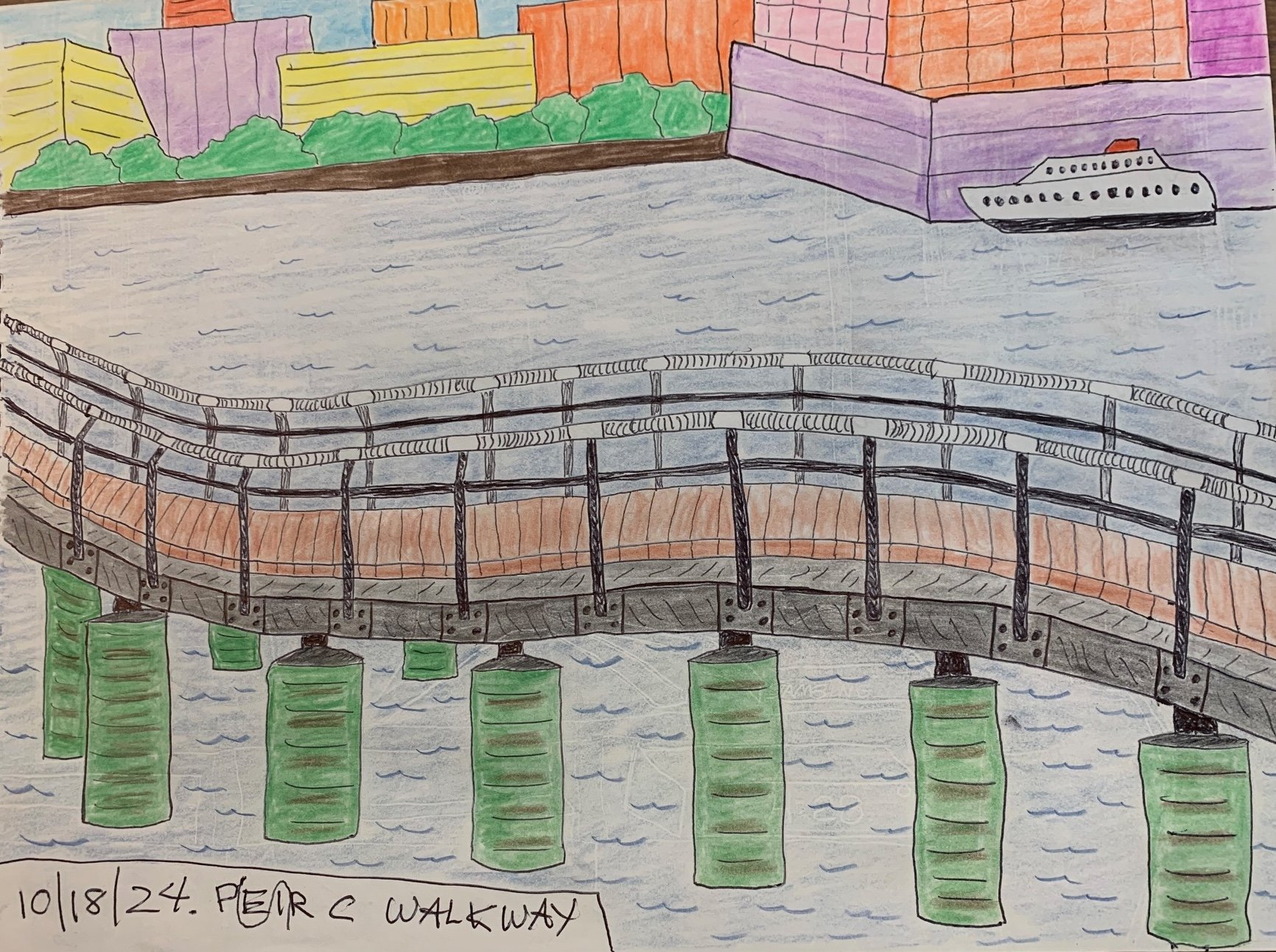Drawing Pretty Pictures in Troubled Times
Yeah, every representation of reality is a cartoon, but my drawings are especially cartoony.
HOBOKEN, ELECTION DAY, 2024. Last month, agitated by things small and big, I stuffed a ballpoint pen and box of colored pencils in my backpack and headed down to the Hoboken waterfront. The scene above caught my eye, so I drew it. My troubles vanished as I focused on contours and colors.
I started drawing in August 2023. I was sitting on the deck of a cottage by the sea, blank-paged journal in my lap, pen in hand, intending to jot down profundities. None came. So I used the pen to draw the picket railing enclosing the deck.
First drawing, August 2023, just good enough for me to keep going.
Whence that whim? I’m not sure. I like doodling in meetings—mazes, spirals, abstract shapes—but I’ve never rendered anything real before. That railing resembled a railing, sort of, when I was done, so I kept drawing. A chair, table, my feet. At first, I drew only with a ballpoint pen. I added color after a friend gave me a set of Prismacolor pencils.
As a science journalist, I often opine on matters on which I lack expertise. Multiverse theories, psychopharmacology, cancer care, artificial intelligence. I recently wrote a book on quantum mechanics after studying it for only 18 months! So naturally I feel qualified after a year of sketching to pontificate on “art.” A few thoughts:
Don’t these barriers seem kind of symbolic?
Like science, philosophy and mathematics, art is reductive, necessarily. If you try to convey all you see—each leaf and wavelet--when you sit beside the Hudson River, you’ll drown in details, like poor Funes in the Borges tale “Funes the Memorious.” You must condense the messy whole to a part or two. Like every scientific model, every work of art is a cartoon, a synecdoche.
This giant pipe to nowhere demanded to be drawn.
Art is an act of free will composed of many mini-choices. You must decide what to draw, then how to draw it. Which details should you depict, which omit? My will isn’t entirely free. My choices are constrained by my limited time, talent, materials.
A single tree displays infinite shades of green, but my pencils give me only two options: “light green” and “gross green.” I could expand my options by buying pencils with different hues, or by switching to watercolors or oil. But my constraints, paradoxically, liberate me, they make choices easier.
View from my living room couch. On the left is a slice of Roy Lichtenstein’s “Aspen Winter Jazz” poster, which I got when I was 13.
I like drawing under-appreciated things, which I can render with my meager skills. I don’t choose subjects because they seem “meaningful.” But after I finish drawing something—like my reflection on my TV screen--sometimes it strikes me as meaningful in ways I hadn’t anticipated.
This means something, not sure what.
That brings me to another issue: Is drawing escapist? And hence unethical? I go back and forth on this question. On the one hand: When I draw, far from looking away from the world, I am paying close attention to it. I see even the most humdrum thing as weirdly beautiful, an emblem of the infinite improbability of everything.
And after all, everything is linked to, one with, everything else. Thou are that. So mystics assure us. So no, drawing is not escapist.
Emblem of everything?
On the other hand: Bullshit. I invoke mystical mumbo jumbo to counter my guilt, to justify doing what I want to do. I draw for the same reason that people meditate: Drawing absorbs me, it keeps the darkness at bay.
When I draw, I’m not thinking, let alone doing anything, about all the injustice out there, the anger and fear, the misery. When times are bad, drawing feels good. So I keep drawing.
The skyscraper’s curvy pattern is real, the colors are whimsical.
Postscript: My friend Richard Gaylord, the curmudgeonly physicist, emailed me several responses to this column:
Re my comment "every representation of reality is a cartoon" Richard responds: “Boltzmann would agree. me too.”
Re my comment “That brings me to another issue: Is drawing escapist? And hence unethical?” Richard responds: “nonsense. escapism isn't unethical; it's essential.”
Re my comment “Drawing absorbs me, it keeps the darkness at bay,” Richard sent me a recording of the John Lennon song “Whatever gets you thru the night”: https://www.youtube.com/watch?v=6lFTD9O-XMw
Further Reading:
Drawing a Pen with the Same Pen and Other Strange Loops
Dumpster Diving: Why I Draw Trash Cans
How Quantum Mechanics Helped Me Escape the Shitshow
My Quantum Experiment (free online book)
I used this to illustrate my last column. I’m using it again because I dig it.










